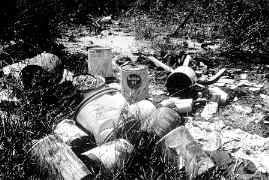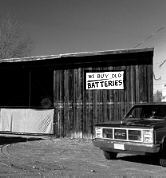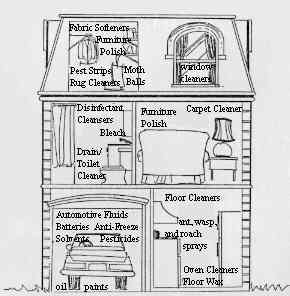 |
Since the end of World War II, the production of organic chemicals in the U.S. has grown from one billion pounds annually to more than 300 billion pounds annually, and its associated chemical waste has grown proportionally. According to the Environmental Protection Agency's (EPA) Toxic Release Inventory in 1992, over 4.3 billion pounds of hazardous wastes were released to the environment by industry in the U.S. Of the approximately 300 million pounds of hazardous wastes disposed of annually in the U.S., 72% of it is hazardous due to a characteristic--ignitable, corrosive, reactive or toxic.
To help control this serious problem, Congress passed the Resource Conservation and Recovery Act (RCRA) in 1976, giving the EPA specific authority to regulate the generation, transportation, and disposal of hazardous waste from "cradle to grave." Other major pieces of federal legislation having to do with hazardous waste are the Comprehensive Environmental Response, Compensation, and Liability Act of 1980 (CERCLA), or "Superfund" and the Superfund Amendments and Reauthorization Act of 1986 (SARA). These Acts provide EPA with both authority and funding to address threats to the public health and environment resulting from uncontrolled spills or dumping of hazardous waste.
 |
In the Albuquerque Metropolitan Area (AMA), our most notable problems resulting from improper hazardous waste disposal is the closing of San Jose #6 well in the South Valley adjacent to the South Valley Superfund site. This site was placed on the Superfund national priorities list (NPL) in 1982, and the Atchison, Topeka, and the Santa Fe Railroad (AT&SF) site, also in the South Valley, was placed on the NPL in 1995. Both sites are currently being studied to determine the most appropriate remedial action
In September of 1982, the Albuquerque Environmental Health Department (EHD) created a plan program to evaluate and deal with the problem of hazardous waste in the AMA. Even though our hazardous waste problems in the AMA are relatively minor compared with the heavily industrialized eastern states, the combined quantity of hazardous and toxic substances could create dangerous and unhealthy situations.
Mismanagement of hazardous wastes, particularly improper disposal and accidental releases, can cause numerous threats to the public health and environment. Improperly managed or disposed wastes can lead to ground or surface water pollution, air pollution, fire and explosions, poisoning via the food chain, and poisonings to human beings through direct contact. Some of the effects of toxic and hazardous wastes on human health include cancer, birth defects, reproductive anomalies, brain and kidney damage, and skin, lung, and heart diseases.
In order for the Albuquerque EHD to develop a successful hazardous waste program, it was first necessary to assess the needs and problems of the local community. For the AMA, the first priorities were the collection of data on local generation of hazardous waste, the quantity of hazardous waste disposed of, and the identification of storage and disposal methods.
An industrial hazardous waste survey for the AMA was conducted in 1981, followed by a residential survey in 1983. From the results of these studies, it is estimated that over eight million pounds of hazardous waste were produced annually in Albuquerque and approximately one-third of it was being disposed of improperly in local landfills, sewer systems (which end up in the Rio Grande), ditches, arroyos, and open spaces.
The residential survey indicated that 1.6 million pounds of hazardous waste per year were disposed of by 96,320 households in Albuquerque. Of this amount, 56% was used motor oil, 19% antifreeze, 11% paints, 10% other recycled oil products, and 2% solvents or thinners The remainder consisted of pesticides, poisons, household cleaners, polishes, drain openers, weed killers and fertilizers, totaling about 2%.
The 1981 industrial waste survey indicated that of the approximately 6.7 million pounds of hazardous waste produced per year by industry in the AMA, 1.0 million pounds were improperly disposed of. In total then, some 2.5 million pounds of hazardous waste and waste oil per year were disposed of in an improper or illegal manner in the sanitary landfill, sanitary sewer system, storm sewer system, or in arroyos or open spaces.
The non-existence of hazardous waste management facilities in the local community at that time contributed to the problems of illegal and indiscriminate hazardous waste disposal. Since the mid 1980s environmental management firms have begun accepting waste for proper disposal at permitted treatment, storage or disposal sites out of state. Used motor oil can be taken to several collection sites in the AMA.
The "cradle to grave" concept mandated by RCRA places responsibility on the waste generator for properly disposing of hazardous wastes d. In reality, however, this is a responsibility which must be shared by everyone--the generator, the transporter, the disposal facility, state and federal regulatory agencies, government health agencies, and the general public. This process is expensive but less so than the costs associated with the clean-up of sites where hazardous wastes were illegally dumped.
 |
The Albuquerque EHD has taken several steps to address the local hazardous waste problem. These include the following:
|
Disposal Method
| ||||
| Substance |
city refuse service
|
dumped down drain
|
hauled to landfill
|
dumped in backyard or open space
|
City of Albuquerque Household Hazardous Waste Collection Center
Waste processed in 1994
| Paints (latex) | 28,600 pounds |
| Used motor oil | 68,640 |
| Anti-freeze | 34,760 |
| Toxic substances (pesticides, etc) | 11,510 |
| Flammable materials (gasoline, etc.) | 27,860 |
| Corrosives (cleaners, acid/basic) | 7,180 |
| Oxidizers (pool chemicals, etc.) | 820 |
| Aerosol Cans (paints, pesticides, etc) | 4,792 |
| Automotive batteries | 1,500 |
| Asbestos | 5,100 |
| Misc. | 4,400 |
| Total of all wastes for 1994......................195,164 pounds | |
(Up to Section V, Back to Environmental Justice, On to Historic Preservation)